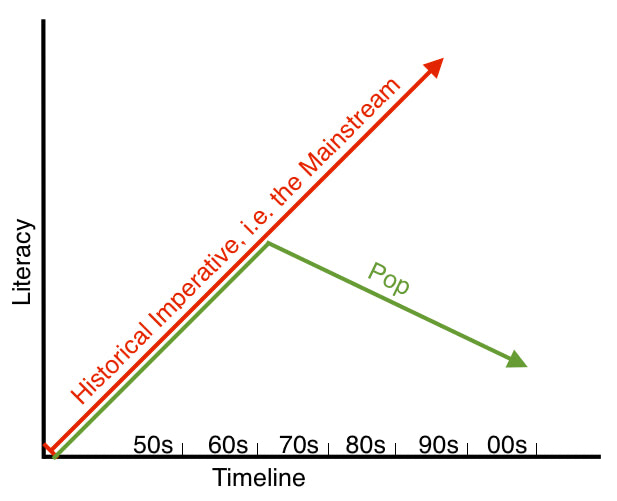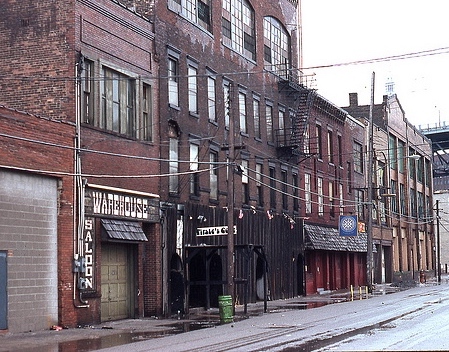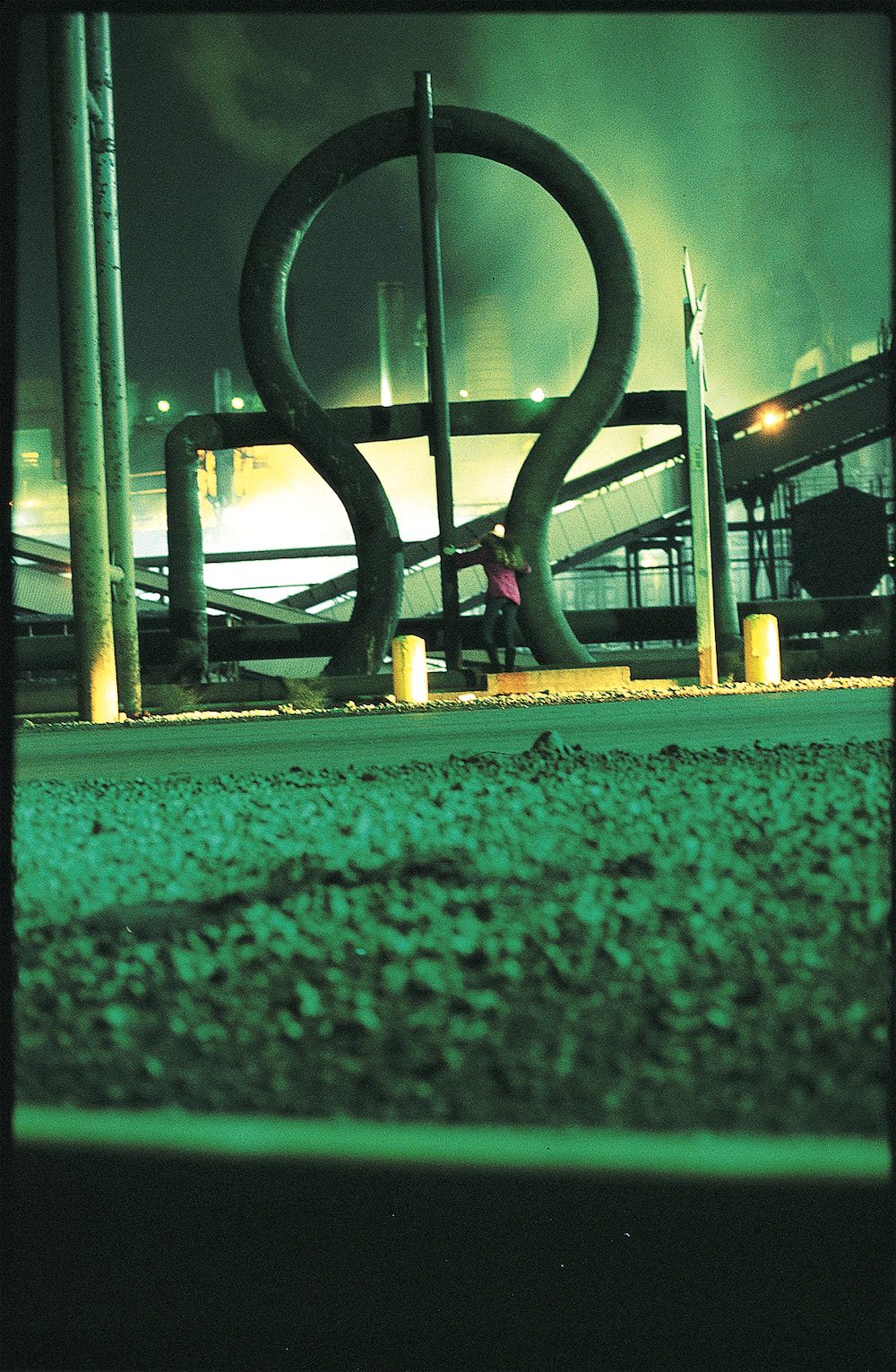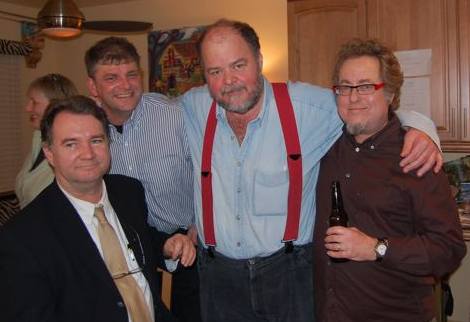
The Pere Ubu Story
What Is Pere Ubu?

Pere Ubu rose from the debris field left by Rocket From The Tombs, a Midwestern hard groove rock band in the tradition of MC5, The Stooges and Alice Cooper. David Thomas formed Pere Ubu to explore the possibilities of story-telling and narrative launched from such a platform. The idea can be put in the simplest terms - the best guitar part is the one that requires the least finger movement; if a song can't work with one chord and the will to rock, then the people involved ought to find other work.
I was going to create a band that Herman Melville or William Faulkner or Raymond Chandler would have wanted to be in. It wasn't going to happen right away. It was going to take years and years but that was my plan.
Who Is Pere Ubu?
It doesn't matter. As long as David Thomas is in charge and The Rules are followed, it's Pere Ubu. No one joins to make money, be a star or get girls. Only musicians attracted by the promise of Pere Ubu, and who will fit, are interested. So far there have been 21 members of the band. They are all Pere Ubu. 'Once Ubu, Always Ubu.'Pere Ubu is about Ideas. Musicians bring Ideas to a band. Personality Cult, personal dress, sunglasses and haircuts, personal hopes and dreams and fears are tiresomely irrelevant. This philosophy, of course, is vehemently opposed by the Live Fast And Die Young Attitude Police.
To see photos of the many different groupings, click here.
Where Is Pere Ubu From?
Formed in
What Others Say
Meredith Rutledge-Borger, Assistant Curator, Museum of the Rock N Roll Hall Of FamePere Ubu is one of the jewels in the crown of America's musical legacy.
Andy Gill, in the New Musical Express, wrote,
Yet by 1978 they had achieved what no other group would even attempt, before or since, they had become the world's only expressionist Rock `n` Roll band, harnessing a range of rock and musique concrete elements together in a sound which drew its power from, and worked on, levels of consciousness previously untouched by popular music. The music Ubu made in 1978 was heart and soul, body and mind, in one.
Ian Penman, also in the NME, wrote:
It is obvious that (the history of) Pere Ubu should not be thought of in terms of a linear development - reducing its entire operation and presence to an exclusive concern for 'working and succeeding in' rock and roll. Unfortunately, most criticism - of Pere Ubu, of many other folks - assumes that words have one meaning, that desires point in a single direction, that ideas are logical; it ignores the fact that the world of language, noise and desire is one of lack, insecurity, interruption, struggle, blundering, disguises, ploys, embarrassed grins.
Greil Marcus, in the 2000 edition of his book Mystery Train, wrote:
Pere Ubu boards a train that passes through a modern nation as if it were an ancient land, all ruin and portent, prophecy and decay. Thus the terrain makes the familiar terrain strange, unseen - new.
Robert Palmer, in the New York Times, wrote:
Pere Ubu was either ahead of its time or out of step altogether; the band's earliest music sounds as if it could have been recorded yesterday, and is likely to keep sounding that way for some time.
Joe Cushley, in Mojo, wrote:
Ubu are generally regarded as the missing link between the Velvets and punk. From the beginning they obviously understood the nuts and bolts of popular music, and then loosened them.
Edwin Pouncey, in The Wire, wrote:
They're the greatest out-rock 'n' roll group of this millennium, and probably the next.
It All Begins
The Pere Ubu project was supposed to be an end, not a beginning. Assembled in August 1975 to be the Crosby Stills Nash & Young of the Cleveland music underground, the plan was to record one, maybe two, singles and then exist no more. None of the musicians wanted to be in yet another rock band. Thomas was devising a different strategy.After I founded the band in 1975, I had in mind a new way of organizing things. Pere Ubu would be a series of distinct, unrelated and short-lived aggregations. It would not be a democracy. It would run according to rules and principles, like a republic. It would be a brotherhood of understanding, cooperation and, yes, trust.
As his band Rocket From The Tombs entered its terminal phase in the summer of 1975, Thomas decided the name of his next group would be 'Pere Ubu,' after the protagonist of Ubu Roi, a play by Frenchman Alfred Jarry. He asked the band's soundman, Tim Wright, to learn an instrument and he would build the new band around him. Tim bought a six string Dan Electro bass guitar and two months later was ready to go. They made plans. Tim was the most influential of band members from the formative period. In 1976 he moved to New York City and joined DNA.
Peter Laughner, one of RFTT's guitarists, asked to join. A steelworker, Tom Herman, and a record store clerk, Scott Krauss, lived at The Plaza, a downtown apartment house owned and
'janitored' by a fellow who played analog synthesizers, Allen Ravenstine.
1
They had made names for themselves jamming in short-lived projects. The first single was recorded at a studio in the basement of a building downtown that housed Channel 3. Thomas found them in the phone book. The engineer, Bill Cavanaugh, told him about a group from Akron who had been in the previous week. They played garbage cans, he said. The name was Devo.
30 Seconds Over Tokyo b/w Heart of Darkness, released in 1975, was the first of four independent releases on Hearpen Records, along with Television's Little Johnny Jewel, signaled the beginning of the New Wave. In the early to mid-70s, the musicians who formed Pere Ubu were part of a fertile rock scene that had also produced
15-60-75, The Mirrors, The Electric Eels, Rocket From The Tombs, Tin Huey, and Devo.

Within months, that first self-produced record, each with a sleeve glued together by Thomas, was being snapped up in London, Paris, Manchester, New York and Minneapolis. Pere Ubu was changing the face of rock music. Over the next four decades they defined the art of cult; refined the voice of the outsider; and inspired the likes of Joy Division, Pixies, Husker Du, Henry Rollins, REM, Sisters of Mercy, Thomas Dolby, Bauhaus, Julian Cope and countless others.
The record was mastered at Cleveland Recording Company by Ken Hamann. For the second single Thomas arranged for it to be recorded at Cleveland Recording, where James Gang, Grand Funk Railroad, and others recorded. Thus began a decades long relationship."Ken Hamann was critical to the growth of Pere Ubu. I might go so far as to say that, without Ken, Pere Ubu wouldn't have amounted to anything near what it did."When Ken retired in 1979, his son Paul Hamann took over the engineering and co-production of Pere Ubu albums until his death in 2017. The studio was moved to a turn-of-the-century, abandoned golf house twenty miles east of Cleveland in 1979 and was renamed Suma.

Pere Ubu premiered at The Viking Saloon, Chester Avenue, on December 31 1975 to promote the release of the Tokyo single.2 The show went well. The band decided to carry on until things didn't go well. Shows were hard to come by. Peter Laughner landed an appearance at Max's Kansas City in New York but, otherwise, the pickings were slim. In November 1976, Jim Dowd, the owner of a bar, the Pirate's Cove on Old River Road in The Flats, was convinced to book the band on a Tuesday night. (The Pirate's Cove was the ground floor of what had been John D. Rockefeller's warehouse.) Fifty people showed up. Dowd was impressed. The band was given a regular slot on Thursday nights and played most Thursdays for a year with intermittent returns to Max's Kansas City.
Early in the summer of 1977, on a visit to his parents, Thomas got a phone call from Cliff Burnstein, head of A&R for Mercury Records. He found the band's third single in a Chicago record store and called to express his enthusiasm and support though he noted that Mercury would not be a good label for Pere Ubu. A week later, Thomas got a call from Chrysalis Records in London. They wanted to sign the group. Thomas called Burnstein to ask his opinion. Burnstein said, "Don't do anything. I'll call you in a week." In that week Burnstein put his own label together at Mercury, Blank Records. He offered to sign Pere Ubu as the first band.

Creative Partners
Four other individuals who partnered with the band in the early years deserve to be noted. Pat Ryan was soundman. He lived at The Plaza. Mik Mellen was the photographer whose work defined the band's visual identity for every early release. His photographs were productions. For the photo used as cover art for Song Of The Bailing Man, he crawled out onto the frozen lake with shards of mirror to capture the setting sun behind him as he focused on the buildings of downtown before him:
He wouldn't take pictures of people. He stopped taking pictures in the early 80s. He didn't say why. He lived at The Plaza.
Jean Kormos was the Ubu Girl. She appeared in the artwork for all releases through to New Picnic Time. She was the only human subject Mellen agreed to photograph. She lived at The Plaza. In the early 80s she moved to New York to open a clothing shop.3
Lastly, there is John 'Johnny Dromette' Thompson. From the beginning he was instrumental in the design, conceptualization and visual representation of Pere Ubu and the bands of Ubu Projex. He was the owner of influential record shop Hideo's Discodrome. He didn't live at The Plaza but he and David shared a house known as The Discohome.
Also deserving a mention is Jim Ellis who published a quarterly (-ish) magazine called CLE, which chronicled the local scene. Johnny Dromette contributed and took out unique ads.4

Secret Scenes In The Seams Of The World
In January 1978, on the eve of the album release and first national tour, Scott Krauss quit the band for the first time. He was replaced by Anton Fier. Within two weeks, Krauss asked to come back. Fier, graciously, stood aside.The first album, The Modern Dance (1978) was a startling work that influenced an entire generation of bands. Three months later, Radar Records released an EP collection of the band's self-produced singles, Datapanik In The Year Zero .5 Dub Housing (1978), released later in the same year, was the masterpiece, "an incomparable work of American genius."
Pere Ubu toured Great Britain and Europe extensively in 1978, supported by the likes of The Pop Group, Nico, Human League, Robyn Hitchcock's Soft Boys and Red Crayola. The Ubu Dance Party tour in November premiered with the secret Ubu Magical Mystery Tour. The audience boarded buses near London's Marble Arch and were driven to Chiselhurst Caves in the southeast where Pere Ubu was setup in an improvised stage in the cave wall.
The attendant pointed out wax plugs in the ceiling. "Keep an eye on them. If they crack," he told us, "Stop playing and get out immediately."
Late in 1979 Tom Herman left and was replaced by Mayo Thompson, the guitarist from 60s Texas psychedelic-rock legends The Red Krayola. A challenging stew of inside-out song structures followed - The Art Of Walking (1980). It was Ubu's best-selling record from this period. Extensive American and European tours followed during which Birdies was recorded for Urgh! A Music War. In March 1981, Pere Ubu supported Gang Of Four on a tour of Britain. Also on the bill were Delta Five and Bush Tetras. Lots of late night card games got played and Ubu introduced 'Reality Dub' - an accurately simulated episode in the song Not Happy during which an on-stage breakdown was simulated. Allen, throwing his synth charts into the air and stormed off - the cue for a secretly signaled Motown vamp springing out of nowhere.
Scott Krauss left the band for the second time. Anton Fier (The Feelies, Peter Laughner's Friction, The Golden Palominos) replaced him, again, and recorded Song Of The Bailing Man (1982), produced by Adam Kidron. At the end of an American tour in December 1981, and after months of growing friction between two members of the group, the band ceased to exist as a functioning unit. Song Of The Bailing Man had yet to be mixed and would not be released until June 1982. There was no band to tour it.
An Interlude
In 1981, Thomas recorded the first of two albums with British folk-rock guitarist Richard Thompson. Three more solo albums featured members of the dormant Ubu. The last of these, 1987's Ubu-like Blame The Messenger (by David Thomas and wooden birds), led to the reanimation of Pere Ubu. The line-up of the wooden birds had been Thomas, Allen Ravenstine, Tony Maimone, Chris Cutler and Jim Jones. Jones was a stalwart on the Cleveland scene and a member of nearly every good band to come from it, at one time or another. Cutler, drummer in English prog-rock outfits Henry Cow and Art Bears, was an early advocate of Ubu and subsequently became a friend of the band.
The Fontana Years
Pere Ubu was reactivated after a band meeting of the wooden birds in the lobby of a hotel in Ijmuiden, Netherlands.6 Manager Nick Hobbs negotiated a contract with Dave Bates at Fontana Records, a subsidiary of Phonogram. The contract was sitting on his desk when, at an appearance in Cleveland, Scott Krauss sat in with the new Pere Ubu. The two drummers line-up sounded good. Krauss was asked to join Pere Ubu as a second drummer.I was a big fan of the Allman Brothers Band and southern rock. I was intrigued by the idea of a two drummer lineup for Pere Ubu.The release of the clattering The Tenement Year followed in March 1988. The 36-date British and European The Avant Garage Returns Tour occupied March to May 1988. Supports included The Mekons and Kampec Dolores. The last two dates Ubu was playing in Athens. After the first show Ubu flew into London in the morning (via Warsaw), filmed The Roland The Rat tv show (BBC), and flew back into Athens in time to walk on stage directly from the airport. The person who played Roland The Rat was a big fan. The band mimed We Have The Technology, which had been chosen as the single from the album. The Tenement Year Tour of the US and Canada in September was a co-bill with John Cale.

(l to r) Allen Ravenstine, Robert Wheeler, David Thomas, and Eric Drew Feldman. March 2008.
Teamed with another Ubu fan, producer Stephen Hague (Pet Shop Boys, New Order, etc.), Ubu shifted gears for 1989's Cloudland (May 15 1989), a journey across the landscape of America as a metaphor. Tired of touring and the grind of it all, Ravenstine retired to take up a career as an airline pilot for Northwest Airlines. He was
replaced by Eric Drew Feldman (Captain Beefheart, Snakefinger).7
The band was brought to London to film the Big World Cafe tv show, Channel Four, followed by a concert at the Mean Fiddler in London, March 16 1989, which was the premiere of the Cloudland material for press and record company. It was also Eric's premiere with the band and the last appearance of the two drummers lineup. Chris Cutler, unable to juggle all the demands of his many musical projects, left the group. The band continued the Cloudland tours as a five-piece.
Worlds In Collision (May 7 1991), produced by Gil Norton (The Pixies), was Stereo Review's Record of The Year. The Worlds In Collision Tour, 26-dates in America and Canada, occupied May to June 1991. It was followed by three Scandinavian outdoor festivals with Kool And The Gang and the Blues Brothers Band and then The Kindness Of Strangers Tour supported by Miracle Legion during which the band appeared on the Late Night With David Letterman. (Phonogram US refused to support the cost of doing it. The band appealed to its fans to donate towards the effort. Fans responded.)
The Pixies invited Pere Ubu to support them on a forty-date tour of America and Canada, October to December 1991, during which Feldman joined them on-stage as a sideman. He subsequently worked on Frank Black's solo projects. When Feldman was unable to record with Ubu because of those commitments the band decided to record what would be the last Fontana album, Story Of My Life (January 25 1993), as a four-piece.

The Band That Never Really Was
Later in the year, Garo Yellin, playing an electrified cello, and veteran of New York City's The Ordinaires and several of Thomas' solo projects, was recruited to fill the synthesizer slot. With the Imago Road Show tour on the horizon, Tony Maimone opted to tour as a sideman in They Might Be Giants instead. He was replaced by Michele Temple who had previously replaced him in the Jones / Krauss 80s side project, Home & Garden. A guitarist in her own band, The Vivians, Thomas asked her to switch to bass for Pere Ubu. This group toured as support on 20 dates of a They Might Be Giants tour in America.
In January 1994, again without a major label, the band recorded demos for a projected album, Songs From The Lost LP. Krauss quit the band, for the third time. Yellin, busy with his quartet in NYC, was replaced by Robert Wheeler, organic farmer, Ravenstine-protegé, and president of the Thomas Alva Edison Birthplace Foundation. Band members were overcome by doubts and uncertainty. Thomas announced that he was ready to become the producer for Pere Ubu and that was what he was going to do.
A New Era And New Blood
Raygun Suitcase (July 31 1995), awarded CD Review's Editors' Choice Award, was recorded to a click track in the hope that Krauss would change his mind. When he didn't, Scott Benedict, the drummer in Temple's group, The Vivians, came in over a weekend, the last weekend of production, and recorded all the drum parts in one of the most magnificent displays of studio-craft the band had ever experienced. The next week he retired to pursue landscape gardening. Steve Mehlman, Benedict's replacement in The Vivians, replaced Benedict in Ubu.In August 1995 Jones retired from the road for health reasons. Herman rejoined the group for the Raygun Suitcase tours, and together with Jim Jones recorded Pennsylvania (April 21 1998), a highly acclaimed album nominated by one of America's preeminent rock critics, Greil Marcus, as the best of 1998.
In 2000 the Rock n Roll Hall of Fame promoted a special event, 55 Years Of Pain, honoring Pere Ubu and the grand-daddies of the Cleveland scene, 15-60-75. The event was repeated at the Royal Festival Hall in London later in the year, and at the Fall Of The Magnetic Empire Festival, curated by Thomas and staged at New York City's Knitting Factory, during which Wayne Kramer of the MC5 joined the group as guitarist for a show.
The release of St Arkansas (May 20 2002) was celebrated by The Mighty Road Tour. A splinter group within the band, referred to as The Pere Ubu Film Group, premiered a live underscore to a rare 3-D screening of Ray Bradbury's It Came From Outer Space at the Royal Festival Hall, London, in October 2002. A highly successful 6-date tour of the underscore in the United Kingdom followed in November 2004. The group premiered its underscore to Roger Corman's X, the Man With X-Ray Eyes at Celebrate Brooklyn (New York City) in 2004.

Keith Moliné, a founding member of David Thomas and two pale boys, had been drafted into the Film Group. Over time, he morphed into being the guitarist in Pere Ubu.
After a decade of perfecting a hypernaturalistic recording method (junk-o-phonics), Thomas produced Why I Hate Women (September 19 2006). It was recorded, for the most part, without the use of professional microphones. Instead an array of junk-o-phones designed by long-time engineer Paul Hamann were used. These included an array of speakers salvaged from broken devices, wooden boxes, metal horns, panes of glass, even doors, wired into specialized electronics.
The band's most ambitious project, which would culminate in the release of "Long Live Père Ubu!" (September 14 2009), began in July 2007. It was an adaptation of Alfred Jarry's Ubu Roi, recorded, again, using junk-o-phonics in such a way that the acoustic quality of the sound itself becomes a narrative voice. A theatrical production, Bring Me The Head Of Ubu Roi, and a radio play of the theatrical production became part of the project. British singer Sarah Jane Morris joined the group for the project. Cult filmmakers, The Brothers Quay, created animations for the theatrical production. On April 24 and 25, 2008, Bring Me The Head Of Ubu Roi premiered at the Queen Elizabeth Hall, London, and was subsequently staged in its full theatrical state at the Animator Festival in Poznan, Poland, July 11 2009, and at the Festival Scènes d'Europe in Reims, France, on Dec. 16 2009. A concert version called Long Live Père - The Spectacle toured in Europe and the USA.
Lady From Shanghai (January 7 2013) marked the fulfillment of a twenty year project working out the Chinese Whispers methodology. A book of the same name, written by David Thomas, accompanied the release. (It was his second book; the first was called The Book Of Hieroglyphs.) In July of 2013, an underscore to the 60s cult film Carnival Of Souls was premiered at the East End Film Festival in London. Songs and musical pieces written for the underscore were developed over the course of a tour of the United Kingdom, Italy, Croatia and Ireland, in November 2013, undertaken by a shock troops version of the band. Each night ideas were improvised from scratch. The album Carnival Of Souls (September 8 2014) resulted. Clarinetist Darryl Boon had contributed to some songs on Lady From Shanghai. Over the course of the making of Carnival Of Souls he was fully integrated into the group.
In 2014, Pere Ubu renounced its US citizenship and applied for creative asylum in Leeds, England, after a cabal of the American Federation Of Musicians and a clique of government clerks in a small town in Vermont determined that Pere Ubu was unworthy of being granted permission to perform in America.
In 2015, with the vinyl box set Elitism For The People, Fire Records began a re-release program that will eventually encompass the entire Pere Ubu catalog. Architectre Of Language followed in 2016 and Drive, He Said in March 2017.

The Pere Ubu Film Group continued with live underscores to the 1962 cult classic Carnival Of Souls. Another subset of the band, The Pere Ubu Moon Unit, dedicated to improvised performances, made more appearances.
In 2016, Cleveland guitarist Gary Siperko (who also is a member of Rocket From The Tombs) joined the band and toured in America with the Coed Jail! lineup.
As the recording of 20 Years In A Montana Missile Silo proceeded through the autumn of 2016, Kristof Hahn, from The Swans, became involved. For a number of years he had been a regular visitor to the Ubu dressing room. After hearing early recordings of the material, he wrote to David, "Gives me goosebumps. I would like to be involved in even a small way." He appears on tracks playing steel guitar.
The Pere Ubu Moon Unit played some European festivals over the summer of 2016. Over the next two years, Ubu returned on several occasions to Europe. A return to the USA remains impossible under current American visa restrictions - several members of the band being British. Between 2016 and 2018, David Thomas died twice. The Long Goodbye was released in 2019.
The Long Goodbye
The Long Goodbye (2019) was the end of a road. David Thomas has been talking about Pere Ubu's journey on the road that passes Satisfied City for many years but, with this album, he declared that they have arrived at the end. Named after Raymond Chandler's novel, Mr. Thomas says "This wraps up every song and story that Pere Ubu has been telling in different ways for the past forty plus years. It is one definitive hour that provides the answers to the questions we've been asking and delivers it up into what I consider the definitive destination. It is not the end of THE road for Pere Ubu but the beginning of a new road."Why Is Pere Ubu?
Well, that's the real question, isn't it? And the answer is DELETEDFootnotes
-
The Plaza was a formerly luxurious apartment house designed in the heyday of the late 19th Century. Located at 32nd Street and Prospect Avenue, running parallel to Millionaire's Row, i.e. Euclid Avenue, it was built to house the mistresses of the millionaire industrialists whose mansions lined Euclid Avenue, often extending to the lake. The courtyard of The Plaza centered on a heart-shaped fountain.
Back to Text
-
Before the premiere Allen Ravenstine, who had been instrumental in convincing band members to become a real band, decided he wasn't ready to play live. He was replaced by Dave Taylor who worked at the same record store as Scott Krauss and played the same EML synthesizers. Taylor graciously bowed out when Ravenstine, in May 1976, announced he was ready to play live.
Back to Text
-
Jean Kormos appears on the Modern Dance Hearpen 45, the back of The Modern Dance, front and back of the Datapanik In The Year Zero EP, Dub Housing and New Picnic Time.
Back to Text
-
'Unique Ideas Lead To Prison' was a frequent Dromette strap-line.
Back to Text
-
What is Datapanik?
Back to Text
- The Duck Principle was the turning point in the discussions. If it looks like a duck and waddles like duck and quacks like a duck then it's a duck. Overwhelmingly the reaction to the Wooden Birds in concert was that the band sounded like Pere Ubu. To deny an historical imperative would be cowardly and unbecoming. Back to Text
- David met Eric in an elevator at a festival in a castle in Bari, Italy. Eric was playing with Snakefinger of The Residents two days before Snakefinger died. David was playing with his Accordion Club based around two identical twin Swedes, the Agaton brothers. Back to Text